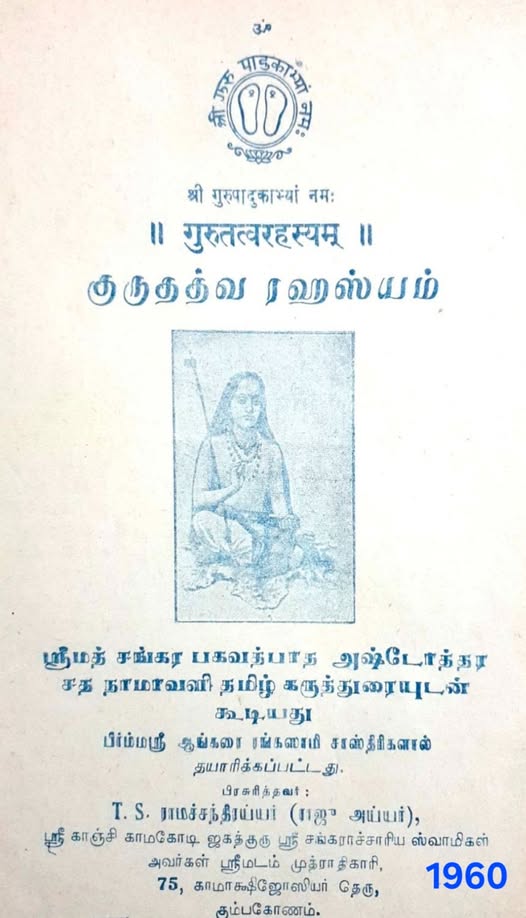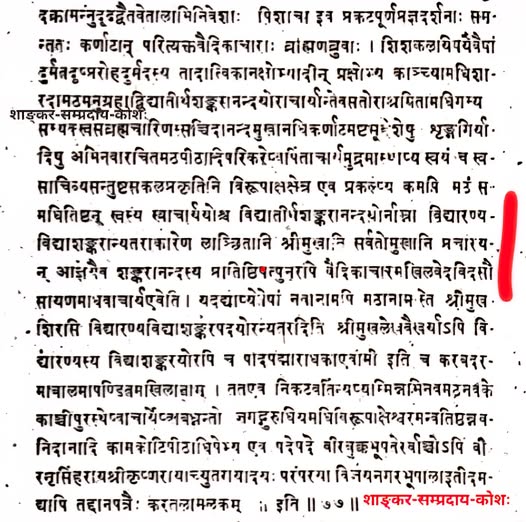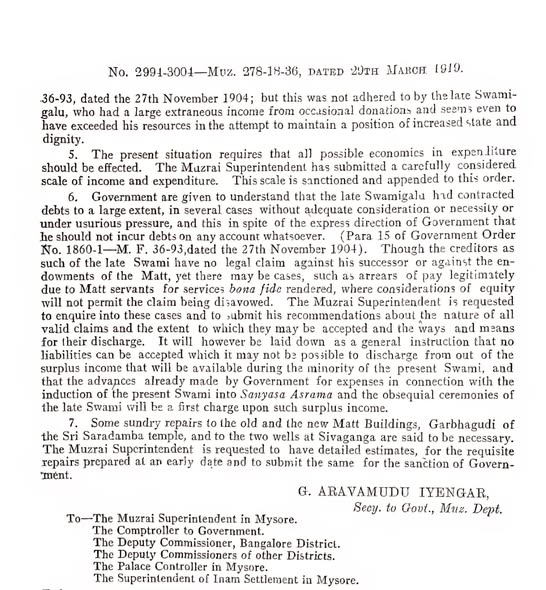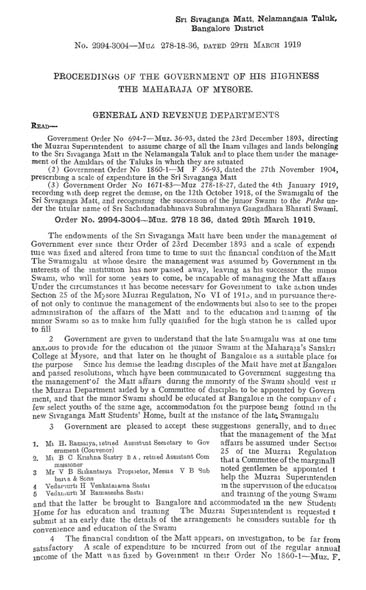-
This information is found in the Sri Kalyana Sevak Rathotsava Pushpa, 1974 (Pushpam 21 of Sri Kalyana Sevaka Granthamala) of Shri Shankeswara Matha.
This Marathi passage narrates in detail, the daily worship of Malayala Brahman, (the guardian deity of the Matha), under a peepul tree (asvattha tree) in the Advaita Matha at Shankeswar in the Karnataka region and also of a special festival of the deity on Rathasaptami day. But the story part of the passage speaks of Shri Adi Sankaracharya’s meeting a Brahmarakshas during the former’s wide travels and overcoming the Brahmarakshas (Malayala Brahman).
Malayala Brahman, as per the story, on admiring the superb attainments and characteristics of the Acharya, offers to serve him, whereupon He ordains Malayala Brahman to protect the institutions established by him and says that Malayala Brahman will be worshipped by the heads of those institutions.(Sri Vidyaranya, Published by The Vidyaranya Vidyapitha Trust, Hampi, 1983)

-
ஸ்ரீஶங்கேஶ்வரம் கரவீரம் மடத்தில் ஒவ்வொரு வருடமும் ரதஸப்தமி அன்று, ஸ்ரீசங்கர பகவத்பாதர்கள் அவர்களின் அருள் வரலாற்றுடன் தொடர்புடையதும், அந்த மடத்தின் காவல் தேவதையுமான மலையாள ப்ரஹ்மா என்னும் ப்ரஹ்மராக்ஷஸுக்குப் பூஜைகள் நடைபெறும்.
இதற்கென, ஹிரண்யகேசி நதிக்கரையில் உள்ள அந்த மடத்தின் தென்புறத்தில் இருக்கும் அஶ்வத்த வ்ருக்ஷத்தின் அடியில் சிவலிங்கத்தை ப்ரதிஷ்டித்து ருத்ராபிஷேகம் செய்து வழிபட்ட பிறகு இதற்கான பூஜைகள் தொடரும்.
ஸ்ரீகரவீர மடத்தின் பழைய வரலாற்றின்படி, ஸ்ரீசங்கரார்ய ஸ்வாமிகள் அவர்கள் மலையாள தேசத்தில் விஜயம் செய்து கொண்டிருந்தபோது, அங்கு ஓரிடத்தில் ஒரு அஶ்வத்த மரத்தில் இருந்த ப்ரஹ்ம ராக்ஷஸ் அவரை வாதிட்டு வெல்ல முயன்றது. அதைத் தோற்கடித்த ஸ்ரீஆசார்யாளின் வாதத் திறன், மதிநுட்பம், புலமை, நேர்மை, தன்னலமற்ற தன்மை போன்ற குணங்களின் கோர்வையைக் கண்டு கொண்ட ப்ரஹ்மராக்ஷஸ் மிகவும் மகிழ்ச்சியடைந்து, ஸ்ரீஆசார்ய ஸ்வாமிகளின் பாதங்களில் பணிவுடன் வணங்கி, ‘நான் தங்கள் சேவகன், அருள் கூர்ந்து தங்களுக்கு சேவை செய்ய எனக்கு உத்தரவு பிறப்பிக்கவும்’ என்று பணிவுடன் வேண்டியது.
ஸ்ரீஆசார்யாள் அவர்களும், தாம் நிறுவிய மடங்களை மலையாள ப்ரஹ்மா பாதுகாத்துவர வேண்டும் எனவும், அந்தந்த மடாதிபதிகளும் தமது மடத்தின் காவல் தெய்வமாக அவரை வணங்குவர், என்றும் அருளினார்.
ஸ்ரீஆதிசங்கர பகவத்பாதாசார்ய ஸ்வாமிகள் அவர்களின் ஆஜ்ஞைப்படி, மடத்தின் காவல் தெய்வமான மலையாள ப்ரஹ்மா வழிபாடு, மடத்தின் பாரம்பரியத்தின்படி தினமும் தொடர வேண்டும். அஶ்வத்த மரத்தினடியில் ருத்ராபிஷேகம் – பூஜை – நைவேத்யம் போன்றவை சிறப்படன் செய்யப்பட வேண்டும்.
1960ஆம் ஆண்டில் ஒரு சமயம் இம்மரம் விழுந்து விட்டதால், மரபு வழக்கப்படி அந்த இடத்தில் ஒரு புதிய அஶ்வத்த மரம் மீண்டும் நடப்பட்டு பூஜைகள் நடந்தேறின.
(ஸ்ரீ கல்யாண் க்ஷேத்ரக் ரதோத்ஸவ புஷ்பம் 1974)

-
ब्रह्मराक्षसतोषकाय नम:
ஸ்ரீசங்கராசார்ய அஷ்டோத்தரத்தரஶத நாமாவளியில் ब्रह्मराक्षसतोषकाय नम: ப்ரஹ்ம ராக்ஷஸ தோஷகாய நம: என்ற நாமாவின் பொருள் மற்றும் வரலாற்றுப் பின்னணி பலருக்கும் தெரிந்திராது. “ப்ரஹ்மராக்ஷஸை ஸந்தோஷப்படுத்தியவர்” என்பதே இதன் பொருள் ஆகும். ப்ராசீன ஶங்கர விஜயங்களில் உள்ளதாக அறியப்படும் இந்த வரலாறு பின்வருமாறு சொல்லப்படுகிறது:-
ஓர் அரசமரத்தில் ஒரு ப்ரஹ்மரக்ஷஸ் குடி கொண்டிருந்ததாயும், அம்மரத்தின் கீழ் ஸ்ரீஆசார்யாள் நிஷ்டையில் அமர்ந்திருந்ததாகவும், அப்பொழுது அது அவர்களின் அருகில் வந்து வணங்கி ‘நான் இந்த மரத்தடியில் வந்தவர்களை விழுங்குவது என்ற பழக்கம் உடையவன். ஆனால் உங்களை விழுங்க என்னால் இயலவில்லை; மிகவும் தேஜஸ்வியாகக் காணப்படும் தாங்கள், சில நாட்கள் இங்கேயே தங்கியிருந்து என்னை அனுக்ரஹித்து மகிழ்விக்க வேண்டும்’ என்று ப்ரார்த்தித்தது. அதற்கிணங்கிய ஸ்ரீஆசார்யாள், அவ்விதமே அங்கிருந்து அதை ஸந்தோஷப்படுத்தி, அதற்குச் ஶாப விமோசனமும் தந்து தமது விஜயத்தைத் தொடர்ந்தார்கள்.
இந்த வரலாற்று விளக்கம் “ஸ்ரீகுருதத்வ ரஹஸ்யம்” என்னும் நூலில் ஆங்கரை ப்ரஹ்மஸ்ரீ ரங்கஸ்வாமி ஶாஸ்த்ரிகளால் தரப்பட்டுள்ளது.
ஸ்ரீஶங்கேஶ்வரம்-கரவீரம் ஶங்கர மடத்தின் வரலாற்றுத் தொகுதிகளில் இந்த வரலாறு சற்று மாறுதலாகக் காண்கின்றது.
(தொடரும்)

-
ப்ரஹ்மராக்ஷஸ தோஷகாய நம:
ஸ்ரீசங்கராசார்ய அஷ்டோத்தரத்தரஶத நாமாவளியில் இருக்கும் ब्रह्मराक्षसतोषकाय नम:
ப்ரஹ்மராக்ஷஸ தோஷகாய நம: என்ற நாமாவின் பொருள் மற்றும் வரலாற்றுப் பின்னணி என்ன?
-
The divine monogram
The divine monogram “Shri Vidya-Shankara”, seen in the mudras of many Advaita Mathas in Karnataka, is revered as a symbol of Guru-Bhakti and spiritual unity. Though it is often said to represent the linga consecrated on the samadhi of Shri Vidyatirtha, there are differing views about its historical origin.
According to Sushama, this divine monogram “Vidya-Shankara” was formed by joining the names of “Shri Vidyatirtha and Shri Shankarananda”, the 51st and 52nd Jagadguru Shankaracharyas of Shri Kanchi Kamakoti Peetham.
स्वस्य स्वाचार्ययोश्च विद्यातीर्थशंकरानन्दयोः नाम्ना विद्यारण्य विद्याशंकर अन्यतराकारेण लाञ्छितानि श्रीमुखानि सर्वतोमुखानि प्रचारयन् आज्ञयैव शंकरानन्दस्य प्रातिष्ठिपत् पुनरपि वैदिकाचारम् ।

-
Disciples beware :
Disciples beware : Help or guidance from another kindred religious institution, like giving diksha or suggesting a successor, doesn’t make your Math a shakha of someone else. It’s only an Act of Goodwill, Not Authority. Every Math is fully Independent, and any claim of control or subordination goes against Article 26 of the Indian Constitution, which protects each Math’s right to manage its own religious and internal affairs.
-
Sivaganga math Succession (1918-19)
(Contd.)
After the Sivaganga Acharya’s maha-samadhi in 1918, the Math was placed under temporary care through a committee of disciples belonging to the Math, by the Muzrai Department, until the young Acharya took charge. This record shows how the Mysore Kings respected the Sivaganga Math’s religious traditions and secular affairs, allowing its own sishyas to manage them in accordance with the customs and usages of the Math. It stands as a model for present-day State Governments on how ancient religious denominations should be protected from any kind of external interference.


-
Appointment of Successor of Sivaganga Math (1918-1919)
Sri Sivaganga Math was founded in 1615 by Sri Sankara Bharati Swami at the request of the Mysore King. It has always been an independent Advaita Math, not under any other Math. This 1918 Government note records the passing of the then Swamigal of Sri Sivaganga Math at Pondicherry and the arrangements made by the Mysore Muzrai Department for the rituals in connection with his maha-samadhi and succession. The late Swamigal, with the approval of His Highness the Maharaja of Mysore, had chosen Vedamurti Rama Sesha Sastri to be initiated into Sanyasa Ashrama as his successor. After his demise, the Government also recognized the new head as Sri Sachidananda Abhinava Subrahmanya Gangadhara Bharati Swami. Earlier, in 1831, the Maharaja of Mysore had settled a dispute between the Sivaganga and Tunga Maths by declaring that the Sivaganga Math shall enjoy the same rights and privileges as Tunga Math, affirming its equal and independent standing. Further, the Government Proceedings dated 4th January 1919 issued by the General and Revenue Departments of His Highness the Maharaja of Mysore formally recognized this succession. The order records, with deep regret, the Swamigal’s passing and confirms that, in accordance with the prior approval of the Government, Vedamurti Rama Sesha Sastri was inducted into Sanyasa Ashrama and recognized as the new head under the title Sri Sachidanandabhinava Subrahmanya Gangadhara Bharati Swami. Neither the previous Swami nor the Government sought any permission or approval from any other Matha for this nomination or installation, confirming that the Sivaganga Math is a separate religious denominational institution.


-
Can Sannyasis give diksha to householders? …4

Can Sannyasis give diksha to householders? …4
மகுடாகமம் ஆசார்ய லக்ஷண விதி
-
Can Sannyasis give diksha to householders? …3
Can Sannyasis give diksha to householders? …3
ராமேஶ்வரம் திருக்கோயிலில்
மகுடாகமம் வழக்கத்தில் இருப்பதாக ஒரு சாரார் கருதுவர். காரணாகமம் என்பது அங்கிருக்கும் சிலரது கருத்து. ராமேஶ்வரம் ஆகமக் கோயில் என்று நீதிமன்ற வழக்குகளில் சிலரால் சொல்லப்பட்டதை அறநிலையத்துறையும் இதுவரை மறுக்கவில்லை. இக் கருத்து யாரால், எதனால் தற்போது முன்வைக்கப்படுகிறது? ஆகமக் கோயில் என்ற கருத்து அப்படியே ஏற்கத் தக்கதா? என்பதெல்லாம் தனித்து விவாதிக்கப்பட வேண்டியவை.
எப்படிப்பட்டவர்களை ஆசார்யர்களாக வரித்து அவர்களிடமிருந்து தீக்ஷை பெற வேண்டும் என்றும் யார் யார் ஆசார்யர்களாக இருக்கக்கூடாது, எவரிடம் தீக்ஷை பெறக்கூடாது என்றும் மகுடாகமத்தில் தெளிவாக சொல்லப்பட்டுள்ளது. இந்த ஆகமம் வைதிக பூஜை மரபு உள்ள திருக்கோயில்களில் வழங்கி வருகிறது.
ஊர்த்வ சைவர்கள் (தில்லை தீக்ஷிதர், திருப்பெருந்துறை நம்பியார், திருவானைக்கா பண்டிதர் உள்ளிட்ட ஆத்மார்த்த பரார்த்த சிவ பூஜைகள் செய்யும் அதிகாரம் கொண்ட ஸ்மார்த்த சைவ மரபினர்) குலத்தில் தோன்றி சாஸ்த்ரம் க்ரியாபாதம் முதல் ஞானபாதம் வரை நன்கு அறிந்து, தந்த்ர ஶாஸ்த்ரமும் நன்கறிந்து, உழைப்பாளியாக இருந்து, நல்ல விஷயம் தெரிந்தவராகவும் இருத்தல் வேண்டும். அதுமட்டுமன்றி அவர் க்ருஹஸ்தராக இருக்கவேண்டும். சிகை போன்றவற்றை தரித்திருக்க வேண்டும்.
இப்போது யாரை தீக்ஷை முதலியன பெறுவதற்காக ஒதுக்க வேண்டும்? அதாவது யாரிடம் தீக்ஷை பெற முடியாது என்ற பட்டியலையும் நாம் பார்க்கலாம்.
ஶாஸ்த்ரம் யோகம் அறியாதவன், நாஸ்திகன், மந்தபுத்தி உள்ளவன், ஞானமற்றவன். தீய பழக்கங்கள் உள்ளவர், பிறர் மனை விழைவோர், மற்றும் ஸந்ந்யாஸிகள் – இவர்களிடமிருந்து தீக்ஷை பெறக்கூடாது என்று தடை செய்கிறது மகுடாகமம்.
இவ்விஷயத்தில் மகுடாகமம் மட்டுமே இல்லை காரணம் போன்ற பிற சைவாகமங்களும் ஒன்றுபட்டு இப்படித்தான் சொல்கின்றன.
உண்மை இப்படி இருக்கும் பக்ஷத்தில் ராமேஶ்வரம் கோவில் அர்ச்சகர்களுக்கு துங்கா மடாதிபதிகள் தீக்ஷை கொடுப்பதற்கும் அவர்கள் கையால் தீக்ஷை பெறுவதற்கும் என்ன ப்ரமாணம் உள்ளது?
இந்த புதிய வழக்கம் ஶாஸ்த்ர விருத்தமானது; முற்றிலும் தடை செய்யப்பட்ட வேண்டியது என்பதே அறிஞர்கள் கருத்து.
ஆக, இதுதான் அங்கே ஸம்ப்ரதாயம் இதுதான் எங்கள் மரபு, கோவில் வழக்கம் என்று பலமாகக் கூவுவோர்கள் ஶாஸ்த்ர விருத்தமான கார்யங்கள் செய்கிறார்களா இல்லையா? என்பதை அவர்களுடைய நெஞ்சத்தைத் தொட்டு சொல்லட்டும். இங்கே நம்மிடம் வாதத்திற்கு வந்து பேசட்டும்.
